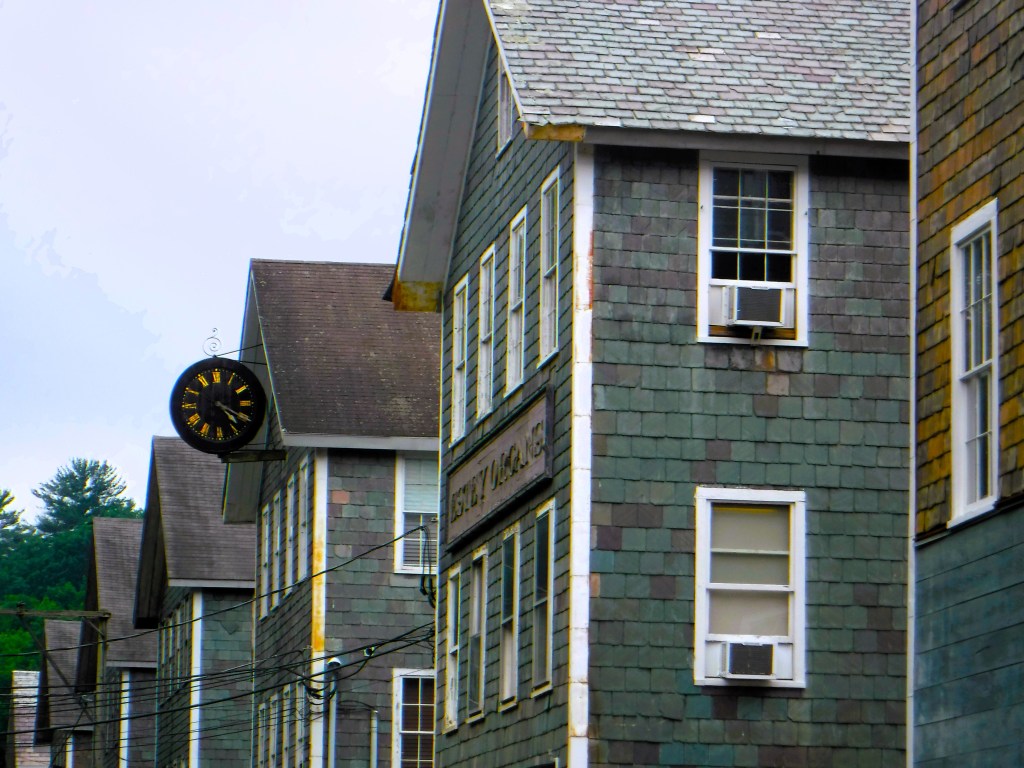Factory buildings of the former Estey Organ Co. stand guard over Birge Street in Brattleboro. Photo by Kevin O’Connor/VTDigger
BRATTLEBORO — Back in the late 1800s and early 1900s, skilled crafters and carvers traveled across oceans to work at this town’s former Estey Organ Co., once the world’s largest manufacturer of pump and pipe instruments.
A century and a half later, the long-shuttered factory may again welcome immigrants.
Developers are seeking to convert one of seven Estey buildings on Birge Street into apartments for refugees in the first phase of what could expand into a larger affordable housing project for the entire community.
“We recognize that our economy is pretty well stalled at the moment because we lack workforce, and we can’t bring workforce in because we don’t have any housing,” local engineer Robert Stevens said. “We’ve been working for a number of years to try to figure out how to crack that code.”
Enter the Estey factory, which produced 500,000 organs from its founding in 1852 to its closing in 1960.
Stevens first eyed the property when he rented space there 30 years ago to start his architectural and engineering firm. Moving on to buy his own Main Street headquarters, he and his colleagues have spearheaded a plethora of projects, including the $23 million restoration of Brattleboro’s Brooks House and $56 million renovation of Bennington’s Putnam Block.
Stevens’ firm revitalizes buildings by culling together money from public and private sources. For the Estey plan, whose finances are still being formulated, developers are seeking low-income housing tax credits as well as government and philanthropic dollars earmarked for helping new Americans.
“Without the support of the funds for refugees,” Stevens said, “the project would not be viable and would not happen.”
The Estey complex already hosts the Multicultural Community Center of the Ethiopian Community Development Council, which has resettled more than 250 refugees from Afghanistan and other global hotspots to Brattleboro, Bennington and surrounding communities in the past two years.
Workers at Brattleboro’s former Estey Organ Co., pictured here circa 1906, built 500,000 instruments between 1852 and 1960. Photo courtesy of the Brattleboro Historical Society
Vermont U.S. Sen. Peter Welch, who has nominated the Estey proposal for federal assistance, recently toured the space.
“This project is truly a win-win — creating affordable and accessible housing,” Welch said, “and restoring a historic building so crucial to Brattleboro’s history.”
For Stevens, the plan has other advantages. The slate-sheathed structures have local water, sewer and road connections and, because they’re listed on the National Register of Historic Places, are eligible for funding that would not be available for new construction.
Developers will first aim to turn the upper two floors of 130 Birge St. into 24 permanent apartments for refugees. If successful, they’ll then seek funds — perhaps by partnering with local employers — in hopes of turning neighboring Estey buildings into affordable workforce housing for all residents.
Barbara George, who owns about two-thirds of the complex, is enthusiastic about the potential. The historian, who helped open the on-site Estey Organ Museum, purchased her first structure in 1993 in the interest of preservation.
“I’m a very reluctant landlord,” George said. “Which is why I’m really happy if somebody is going to do this.”
The lack of affordable housing is one of Brattleboro’s most cited problems. A recent municipally sponsored Housing Action Plan found an immediate need for more than 500 local units.
Stevens hopes to finalize the first-phase plans and funding by next summer and begin construction of the apartments for refugees soon after.
“Hopefully we can add a substantive amount of housing to this community,” the engineer said. “We have a lot of work to do to get there, and we need a lot of help.”
Read the story on VTDigger here: Once a workplace for immigrants, historic Brattleboro factory may house refugees.

